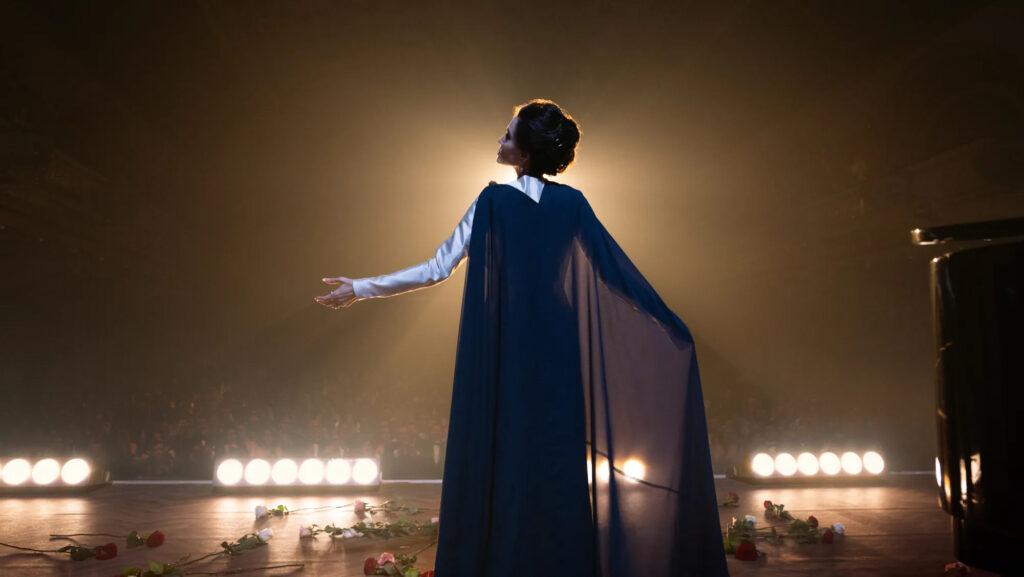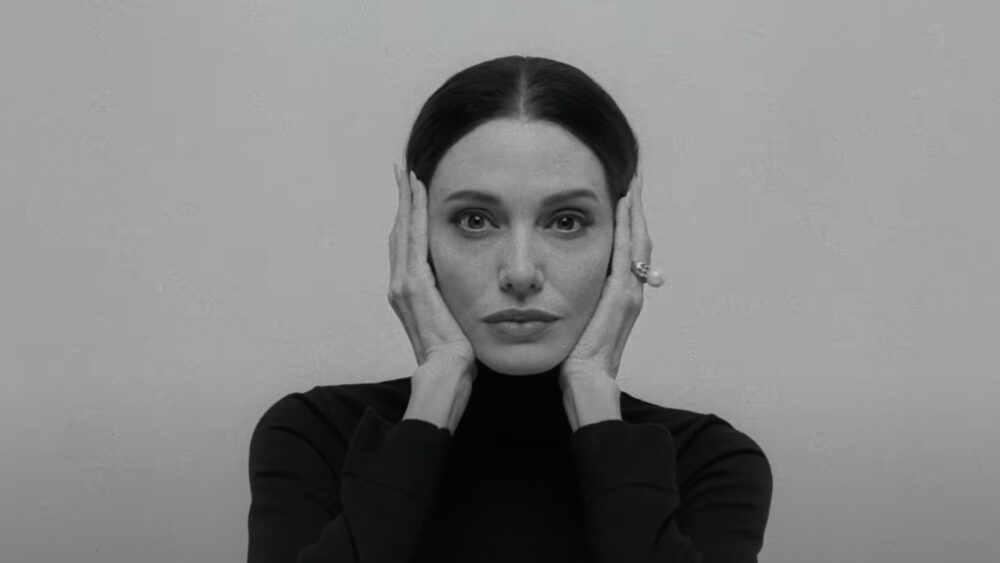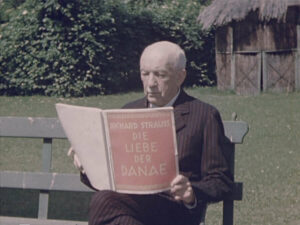As I settled into my seat on the last Sunday of September, I wondered why everyone else had packed into Alice Tully Hall to be among the first to see Pablo Larraín’s latest film Maria. For sixty-two years, the New York Film Festival has attracted cinephiles from all over to sample a highly curated selection of the most challenging new movies, and Maria’s two screenings sold out especially quickly. Were all these people as fascinated as I was to see what the acclaimed Chilean director had conjured up on the subject of Maria Callas, opera’s most celebrated singer?
Like his previous works about near-mythic women of the 20th century — Jackie about Jacqueline Kennedy Onassis and Spencer about Diana, Princess of Wales—Maria premiered at the Venice Film Festival. Its arrival there was greeted with a storm of curiosity due not so much to its heroine but as to Angelina Jolie, the actress portraying her.
In a discussion before the festival with several film friends, I confessed I’d never watched a Jolie movie before: they rattled off lots of titles but I always shook my head. While I was surprised that I had seen about a half dozen featuring Brad Pitt, the star’s equally glamourous ex-husband who also had a new film at Venice, my knowledge of Jolie was limited to paparazzi-driven accounts of her colorful, sometimes controversial offscreen life, with or without Pitt.
Though reviews from Venice had been almost uniformly ecstatic, I was skeptical but that evening I witnessed how quietly mesmerizing Jolie’s performance in Maria is. Larraín mentioned that he was surprised by a stoicism Jolie brought to her portrayal which is suffused with an immensely poignant yet luminous resignation.

Since I had seen Jackie and Spencer as well as El Conde, Larraìn’s recent film about dictator Augusto Pinochet, I knew not to expect Maria to be a conventional biopic, a genre I don’t much enjoy anyway. Written by Steven Knight, Maria is a haunting and elegiac fictionalized account of the soprano’s final seven days in Paris during September 1977. It’s framed by conversations the diva has with a young interviewer named Mandrax, after the one of the prescription drugs upon which she’s become increasingly dependent. Played by Kodi Smit-McPhee, best remembered for his breakout role in Jane Campion’s The Power of the Dog, Mandrax discreetly probes the apparently retired diva and her responses, abetted by frequent flashbacks, guide the viewer through a terribly sad non-chronological exploration of Callas’s life during a time when she also attempts to revive her moribund singing career, perhaps as a distraction from her failing health.
The complexities of Callas’s career and private life could not be examined in a two-hour film, though many documentarians have tried, so Maria’s creators radically simplify her situation by suggesting that the diva’s all-consuming tryst with Aristotle Onassis was the driving reason behind her withdrawal from performing. A dozen years after her most final opera appearances, we follow a desperate Callas coaching with a supportive pianist in an empty theater; she even solicits opinions on the state of her voice from her devoted if cowed cook Bruna (played by Alba Rohrwacher) and her more forthright and protective chauffeur Ferruccio (Pierfrancesco Favino).
Though portrayed reductively, the relationship with Onassis (Haluk Bilginer) provides some of the film’s most moving moments, particularly a devastating encounter between them, long after his marriage to Jackie, as he lies dying. Their interactions are much more convincing than Callas’s awkward luncheon encounter with Caspar Phillipson’s JFK, the film’s most unconvincing scene. Callas’s decline must be taken on faith as Jolie, thanks to superb make-up and hair people, looks ravishing throughout; sometimes her resemblance to Callas is simply uncanny. Without resorting to outright impersonation, she gets much right about the diva’s carriage as well as her complexly idiosyncratic accent.
In the Q & A that followed my NYFF62 screening, Jolie went into some detail about the rigorous, months-long vocal training she undertook to attempt to sound like the aging Callas. Quite often in the film, we hear Jolie singing either on her own or mixed with the soprano’s voice. That device is used when we experience Jolie in 1977 crosscut with Jolie lip-synching moments from Norma and Anna Bolena during the 1950s performances at La Scala.
Through her vocal coaching, Jolie sought to make her opera performances as realistic as possible, and they’re actually quite convincing. The film opens with stark black-and-white footage of Jolie miming Desdemona’s “Ave Maria” fromOtello juxtaposed with a remarkably detailed montage of her life—knowledgeable viewers will recognize how precisely the filmmaker and his crew have recreated iconic images of Callas. Ave Maria indeed!
The trailer may give the impression that Maria consists primarily of Jolie intoning all sorts of grandiose diva pronouncements, but while these moments are present, they don’t suffocate the film. I imagine that Larraín and Knight may have included them to indicate to a wide general audience the intense, even obsessive commitment needed to perform opera, especially for an artist as rigorous as Callas.
When plans for Maria were first announced, many “Callas widows or widowers” were indignant that “their” icon would be portrayed by a Hollywood star, but some reactions to the finished film have been enthusiastic. I heard that one group drove to Staten Island from Manhattan to catch the New York Film Festival’s only outer-borough Maria screening; I understand they loved it. I snagged a ticket to a special Festival encore Maria screening and nervously offered it to a friend who owns at least one copy of every recorded note of Callas and many of the countless books in both English and French published about her. I was prepared for the worst when he contacted me after the movie. Despite early reservations, he loved Maria and was quite touched by it, and I expect many more will be too. Film friends of mine with little or no acquaintance with opera have been unanimous in their admiration for Larraín’s and in particular Jolie’s achievements, an admiration that seems to parallel Larraín’s for his star and subject.
In his remarks before the screening Larraìn spoke movingly of his long love for opera which he attributes to his mother who regularly took him and his brother to performances. The film is suffused with that ardor, not only in sequences of Callas singing but also in the director’s use of other operatic music from Madama Butterfly and Tosca, for example.

His treatment of Callas, the only figure of his Jackie-Spencer-Maria trilogy to earn her own status rather than acquire it though marriage to an important man, is much more humane and sympathetic than that of those who loudly proclaimed their Callas love, namely Franco Zeffirelli and Terrence McNally, who created much more problematic works about the soprano.

Years ago, one never heard the term “Oscar bait,” but Maria has definitely been accused of being Jolie’s vehicle for a Best Actress nomination. When one notes that since the turn of this century, twenty-nine Best Actress nominations have gone to women playing real-life figures including Natalie Portman for Jackie and Kristen Stewart for Spencer, is there any doubt that Jolie will be among the five names announced early next year?
Jolie mentioned that singers from the Met had been invited to the NYFF62 premiere and photos of her with several including Nadine Sierra and Benjamin Bernheim were later circulated. The Met recently co-sponsored a Maria screening at the Paris Theater appropriately scheduled for the night after its Tosca gala starring Lise Davidsen. The ever-publicity-shy Yannick Nézet-Séguin helped introduce the film that evening.
Most will watch Maria when it arrives on Netflix,who purchased the film after its Venice premiere, beginning on December 11. (Seemingly no one at the streaming service realized that its premiere might have easily been moved to a week or so earlier to coincide with Callas’s 101st birthday.) However, before Netflix drops it, Maria will be shown in theaters around the country beginning tomorrow and I encourage anyone who is able to see the film on a big screen. Its Budapest, Paris, and Milan locations look glorious thanks to Ed Lachman, the great cinematographer whose stellar work here is even more impressive knowing he now requires a wheelchair to get around.
New Yorkers can see Maria for themselves in theaters at the recently renovated Paris as part of the theater’s compelling series “Divas and Despots: Ten Portraits by Pablo Larraìn.”








Comments